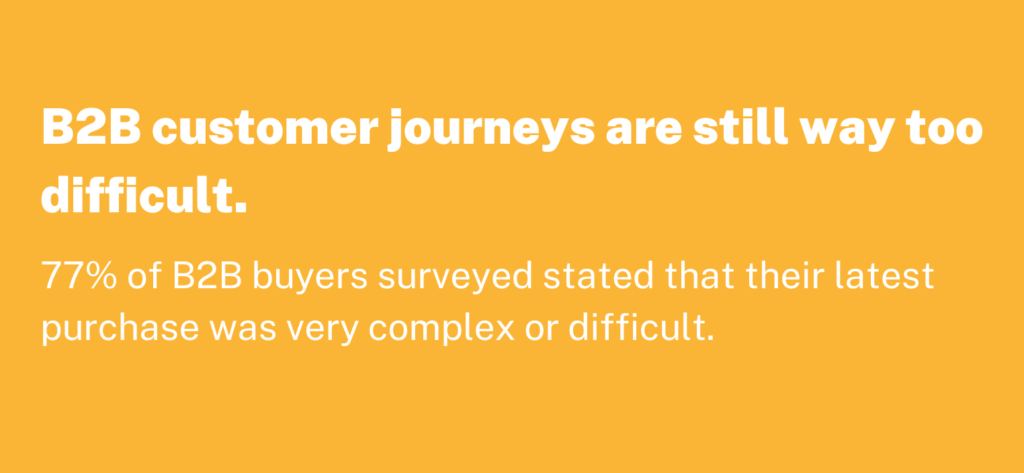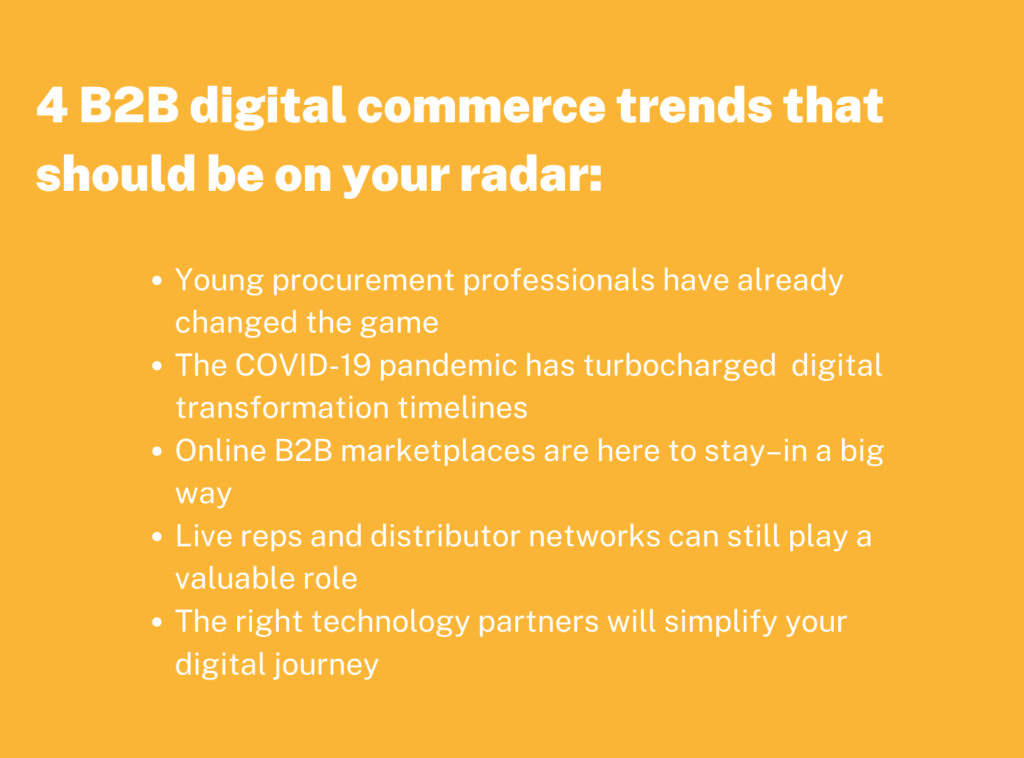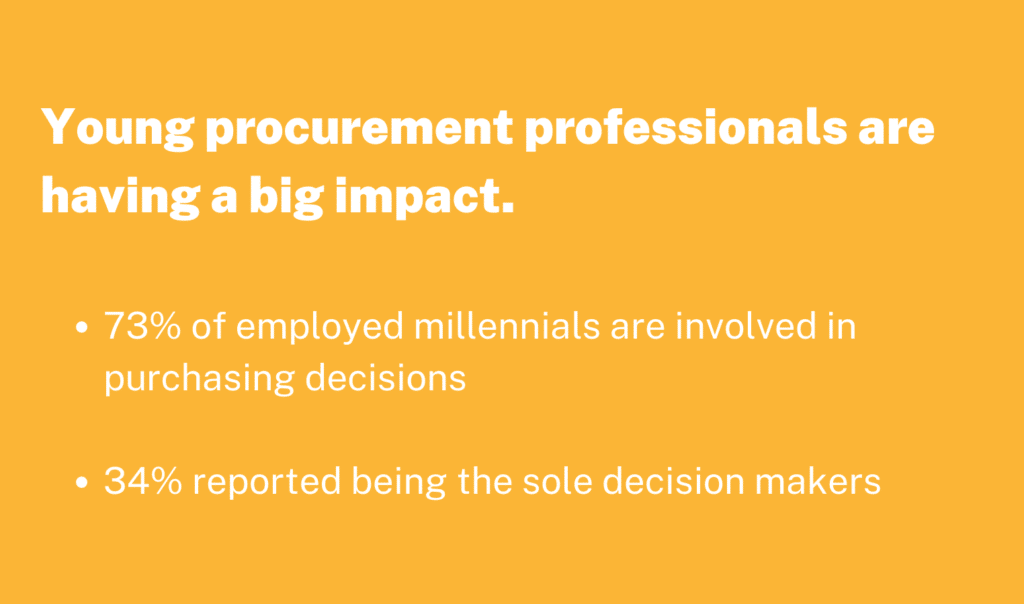Why Are B2B Purchases Still More Difficult Than B2C Buying Experiences?
It’s all too easy to spot the differences between typical B2B and B2C buying experiences. On the consumer side, shoppers have been the beneficiaries of countless technology and CX-focused initiatives over the years that have led to impressively simple, intelligent, and frictionless online and in-store buying experiences—no matter where they choose to shop. Today, consumers can quickly find virtually any product or service they’re looking for, learn everything they need to know to make an informed and confident purchasing decision in a few minutes, and then choose from a list of fast and convenient delivery or in-store pick-up options through advanced site search and semantic search technologies.
Procurement professionals and corporate buyers, on the other hand, often face a very different journey, where they are required to navigate complex internal approval and payment processes, interact with confusing and competing networks of distributors and sales reps, and wait days or weeks for items to be delivered. All too frequently, corporate buyers are still subjected to browsing a retrofitted, barely searchable catalog online, struggling with inadequate product search functionality—and then picking up the phone or sending a fax (that’s right, a fax) to place an order. When was the last time you saw that in the consumer world? The lack of a streamlined product discovery process often compounds these issues.

Of course, there’s an argument that certain ingrained factors will always prevent B2B transactions from becoming as easy and convenient as consumer shopping experiences. The dollar amounts and order volumes of B2B purchases are usually much higher than consumer purchases, which necessitates more formal decision processes and multiple levels of approvals. In many industries, parts and supplies are incredibly complex and specialized—to the point that orders require conversations between trained and knowledgeable humans on both sides of the transaction. There is a deeply ingrained, long-standing technological and organizational infrastructure involving distributors and wholesalers that makes simple, direct connections between manufacturers and their end customers more demanding. This complexity often necessitates a more sophisticated semantic search functionality to aid buyers in finding precisely what they need.
These long-standing dynamics certainly help explain why there is still a gap between B2C and B2B purchasing experiences—and why customer experience improvements have been so slow to develop in the B2B world. But does it have to be this way? Will this gap always exist—or can B2B commerce start to look more like the B2C world regarding speed, convenience, and simplicity? Recent developments strongly suggest that the gap is already closing; that the B2B buying journey is in the middle of a significant transformation; and that B2B manufacturers, distributors, and sellers who resist or ignore this transformation will risk becoming less relevant and competitive.

To avoid that fate—and successfully close the long-standing gap between B2B and B2C buying experiences—here are five core concepts that should be informing and guiding every digital B2B commerce strategy:
1. Young, digital native procurement professionals are taking over
As of 2015 (practically an eternity ago), 73% of employed Millennials were already involved with purchasing decisions at their companies, and 34% reported being the sole decision-makers. In the past 8 years, that number has grown as many GenZ professionals have joined the mix.
In other words, digital-native B2B buyers are already calling the shots at many companies, and they have very little patience for protracted price and payment term negotiations with vendors, chasing approval forms over email, and other clunky, non-digital (or only partially digital) B2B buying experiences. Millennials and GenZ-ers simply expect the ability to buy business supplies the same way they buy everything else—using a website or app with sophisticated (usually AI-powered) intention-focused product discovery capabilities, a streamlined shopping and payment experience, and fast, convenient delivery options. If B2B vendors can’t provide these experiences—and successfully adapt them to handle the increased complexity that’s often inherent in B2B transactions—younger B2B purchasers will actively search for partners that can.

2. The pandemic has turbocharged the move to digital B2B purchasing
If the influx of young digital-native workers launched the B2B digital transformation, the COVID pandemic kicked it into overdrive. Out of pure necessity, B2B sellers had to give their customers new digital buying, shipping, and logistics options to accommodate different ways of working—and do it all in a very short period of time. B2B vendors that pivoted and built out these new digital options quickly obviously earned a critical, permanent advantage. Those that lagged must catch up because these pandemic-driven dynamics and approaches have created a new, permanent set of baseline digital expectations and requirements for B2B transactions.
3. Online B2B marketplaces have arrived
B2C marketplaces like Amazon—where people can search, compare, and buy products from thousands of vendors using one website or app—became a central driving force in the consumer online shopping space years ago. But for a long time, these types of digital marketplaces were relatively rare (and mostly optional) in the B2B arena.
With Grainger, Amazon Business, and other more specialized B2B marketplaces coming online and growing at an incredible pace, that is no longer the case. If B2B marketplaces don’t have a prominent place in your current digital strategy, they definitely should. The ease of product discovery in these marketplaces often mirrors that of B2C platforms, enhancing the buying experience for B2B professionals.
4. Live reps and distributors can still play an important role
Creating simple, convenient, and modern digital buying experiences for your B2B customers doesn’t mean replacing tried-and-true networks of live reps and distributors. In many cases, those live connections and relationships still have an essential part to play in the most complex, specialized, high-dollar B2B transactions. Instead, it’s about re-imagining the role they should play in a modern, streamlined digital buyer’s journey. What types of transactions need that personal engagement and interaction—and which could be better served by digital-only transactions? How can new digital elements improve, support, and transform traditional networks and processes? How can your reps and distributor networks add value—without slowing things down or adding unnecessary complications?
The answers to these questions will differ for every B2B seller—depending on unique circumstances and market dynamics. But it’s essential to figure out how these traditional elements can become a seamless part of your modern, cohesive, and increasingly digital buyer’s journey.
5. The right technology partners can accelerate and simplify your journey
Advanced new technologies that have already become mainstream in the consumer space also have the potential to overcome the most significant challenges B2B sellers face in their digital commerce journeys. New AI-powered product search capabilities, visual searching, 3D modeling, sophisticated digital approval and payment workflows, and many other innovations directly address the issues that have made it challenging to create B2B experiences that are as easy and seamless as consumer shopping experiences. Of course, adding and integrating those technologies into existing, complex B2B systems in a practical, affordable way isn’t easy. Fortunately, e-commerce technology companies see massive opportunities in the B2B space, and they are focusing significant resources on solutions and approaches that do precisely that.
For example, Lucidworks is actively creating sophisticated new product search solutions explicitly designed to meet the requirements of B2B sellers. Other e-commerce tech companies are doing the same in their specialty areas. That means you can already take advantage of B2B digital commerce solutions that:
- Allow your customers to search and explore extensive and complex B2B catalogs—and find exactly what they’re looking for—quickly and efficiently through enhanced product discovery and product search.
- Provide unified information about different related products, suppliers, and vendors in one convenient location—organized in a way that makes sense through effective site search.
- Quickly create customized product descriptions and images that perfectly match the requirements of your market and specific sets of customers.
- Provide enhanced B2B payment capabilities that allow customers to pay using purchase orders, invoices, or whatever methods they’re most comfortable with.
- Manage complex orders, returns, and other B2B transactions quickly and efficiently.
And the list goes on. The bottom line is that with a smart, thoughtful approach and the right technology partners, there is a clear, achievable path to the kinds of B2B buyers’ experiences that rival today’s best consumer experiences and deliver the product discovery speed and convenience your customers now expect. So yes, you can close the gap between B2C and B2B buying experiences. And you can do it today.